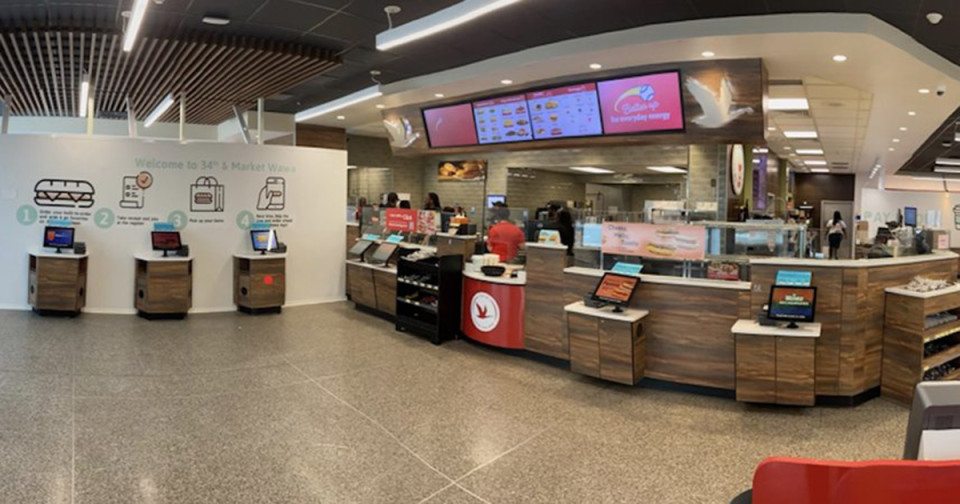A Wawa for the Coming Dystopia
Wawa's experiment in seamless hoagie logistics is flawed.

Wawa’s new all-digital store in University City / Photograph courtesy of Wawa
Look, it’s not often that I get to quote a paper from the Norwegian University of Science and Technology here. It’s not often that I get to talk about Buckminster Fuller and the “dystopian origins of the industrial design profession” and also Wawa all in the same breath.
But here we are.
For the last little while, Wawa has been experimenting with various methods for making the entire experience more efficient. For you, sure — with their apps and online ordering and curbside pickup and whatnot — but also (and maybe more importantly) for itself.
A couple months back, our own Laura Swartz wrote about the opening of the first all-digital Wawa in University City. It has no shelves and no shopping. All transactions (except the self-serve coffee) are handled through Wawa’s app and the kiosks we’ve all become accustomed to ordering our hoagies through. At first, it seemed like an entirely slick, sterile and soulless place. A kind of liminal space existing in a state of perfect order under harsh white lights, made for the quick service of autonomous worker drones (read: you) going to and from their designated daily tasks. A Wawa for robots, run by robots, essentially.
Then, a few weekends ago, Slate wrote about it — horrified by the banality that comes with anti-regional national branding and uniform corporate design. In the Slate piece, Nadira Goffe wrote: “What’s happening to Wawa — bringing the chain into alignment with national brands that have zero sense of local specificity — ruins its charm. Streamlining the in-store experience to something digitized, all boiled down to the touchscreen, takes away the joy of talking to the staff, of surveying your options — seeing those Peanut Chews you forgot about but now want — and of customizing some items by chatting up employees. But, more importantly, these modern spacecrafts no longer feel like home.”
And I couldn’t agree more.
Neither could Alexander Jayko Fossland who, in his paper, “The Best Way to Predict the Future is to Design It”, talks about the origins of industrial design and, tangentially, this urge toward a streamlined placelessness that seems to haunt the new robot Wawa. He quotes designer and author Victor Papanek, who says, “In America, Industrial Design […] was a child of the Depression. At first glance the swollen belly of a child suffering from malnutrition gives it the appearance of being well fed; later you notice the emaciated arms and legs. The products of early American industrial design convey the same sleek obesity and have the same weaknesses.”
The same sleek obesity. I like that. And it’s apt, I think. Because for us — for Pennsylvanians, for those who grew up with Wawa — it has always existed as a kind of dis-aggregated town square. A place where everyone goes and rubs shoulders with everyone else; where you are forced to confront your neighbors over the chip rack or at the hoagie counter. It is, in no small part, what the sociologist Ray Oldenberg called “a Third Place” — somewhere that wasn’t work and wasn’t home but was the place where you went between those two other poles of human existence. Bars, churches, diners — these are the traditional American Third Places. But here, we also have the local Wawa. It is the place that makes this place feel like someplace.
But Dystopian Wawa? Being there feels like being nowhere. Or like being anywhere, which is almost worse. And that kind of shiny, address-scrubbed blandness will always have an uncanny valley type effect on people here because Wawas are supposed to have personality. There’s supposed to be a grubby kind of humanness to them. They’re NOT supposed to be dead-eyed simulacra of the “Wawa experience” smoothed and sanded and epoxy-sealed for maximum efficiency. Fossland boils down Buckminster Fuller’s almost weirdly prescient opinion on the matter like this: “The dystopian origins of the Industrial Design profession, combined with its established beneficial abilities can leave a paranoia concerning a lack of direction. One’s own Professional pride in beneficial abilities has little value if these abilities can only be seen in a monetary context. When students are taught to utilize their talents exclusively as capital’s tool to exploit humanity’s curiosity towards newness, confidence and self-esteem is displaced by distrust in design.”
In other words, let Wawa be Wawa.

